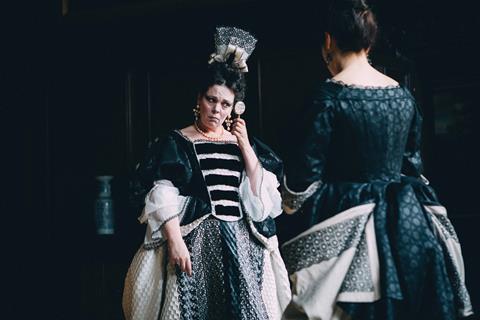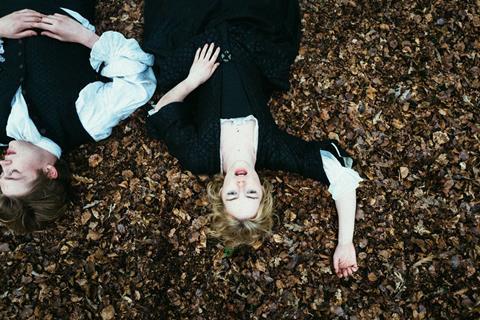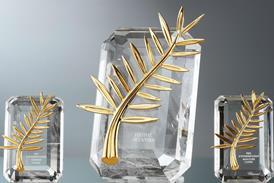Beginning as a spec script from a first-timer, The Favourite reinvents the staid English period drama thanks to the input of three foreign-born producers, a Greek director and an Australian screenwriter. Screen tracks the 20-year journey from page to screen.

Even by the oft-protracted standards of film development, the journey of The Favourite from first mooting to the screen has been a long haul, taking an epic 20 years from its origins as a spec script from a first-time writer to its current position as an Oscar and Bafta front-runner. “It’s been development purgatory, hell and heaven — all three together,” smiles Ceci Dempsey, one of the four producers who brought the film to life.
The Favourite, directed by Yorgos Lanthimos, tells the remarkable true story of three women at the heart of the court of Queen Anne: the monarch herself (Olivia Colman); her lover and trusted adviser Lady Sarah Churchill (Rachel Weisz), who in this telling essentially ruled in Anne’s place; and servant Abigail Hill (Emma Stone), who supplants Lady Sarah in the royal affections, stealing her position.
Deborah Davis, who has a background in both journalism and the legal profession (including a stint writing for Screen under the editorship of Oscar Moore), came across the seeds of the story in London’s Evening Standard newspaper. “It wasn’t a big article,” she recalls. “It was like a snippet. The snippet was, everyone knows that Queen Anne was having an affair with Sarah, Duchess of Marlborough. I’m a keen historian but I didn’t know anything about this.”
Davis was delighted to discover there existed an abundance of primary sources, including letters between Sarah and Anne, and Sarah’s memoir “about the breakdown of her relationship with Anne and how Abigail became the absolute favourite… I thought that was a perfect story to explore the role of women in power in a historical setting.” She called her screenplay Balance Of Power.
The budding screenwriter pitched the project to a producer friend Dorothy Berwin, who at this time was working with Ceci Dempsey — together the pair had produced Rose Troche’s 1998 US indie comedy Bedrooms And Hallways. “For one reason or another, Dorothy was not able to take it on,” recalls Davis. “When Ceci subsequently set up on her own, I was back in contact with her and she was very keen on it.”
By this time, Davis had completed an MA in screenwriting at the University of East Anglia, before being selected for a radio drama course run by the BBC. Dempsey won backing for further development of the screenplay from the UK Film Council (UKFC), which at the time had a development fund run by Jenny Borgars.
False starts
During these early years of development, two other names became associated with the project: director Carine Adler, who made the acclaimed 1997 film Under The Skin starring Samantha Morton, and screenwriter Michael Hirst, whose credits include Shekhar Kapur’s 1998 historical drama Elizabeth. Dempsey feels that neither are relevant to the discussion of the film that eventually came to fruition. Regarding Adler, she says: “That was a very early attachment, and absolutely nothing to do with this film,” while Hirst completed one draft “which has nothing to do with the final film. It’s like a completely separate entity, that whole mini time period.”
Meanwhile, Dempsey was having no luck snagging production finance. “There was a general resistance to the fact it was a period film,” she explains. “That coupled with the fact there was a lot of same-sex romance in it really freaked people out. It was a very odd thing. People were attracted to the project, ‘Great project. Now can we make it about the Duke and Duchess of Marlborough?’ Or, ‘Can we just change this, this and this,’ which was in fact changing everything.
“Of course the answer was no. That kept happening over and over again. I was looking through some documents, and I came across one that said the maximum budget would be £5m [$6.4m] , and that was considered an outrageous number. Which looking back is quite amusing. But it would have been a very dry take on this story and more a three-hander. People just didn’t see it for what it was.”

Balance Of Power finally found new life when Ed Guiney and Andrew Lowe’s Dublin-headquartered Element Pictures came on board. At the end of 2005, Lee Magiday left Focus Features, where she had headed up the company’s European offices as vice president of acquisitions and production. In 2006, she joined Element, setting up its London office as head of development.
At Focus, Magiday had been tracking Balance Of Power: she knew Dempsey, had worked with her at the London office of sales and production company Lumiere, and both were US-UK dual nationals. Magiday brought it to her partners at Element, who embraced the creative pitch: an All About Eve story at the court of Queen Anne.
Given the challenges Dempsey had been facing, there were many reasons for Element to show caution, including the fact the story pivoted around a monarch who was not high on the list of UK royals that audiences are presumed to know or care about. But, recalls Guiney, who produces the film alongside Dempsey, Lanthimos and Magiday, “We were not as analytical or clever about it as you might imagine. Maybe the fact that I’m Irish, and Lee and Ceci are American, although they live in the UK, maybe we were less aware of Queen Anne’s place in history. It just sounded like an amazing story, it really was that simple. At the beginning of a project, all you see is the potential, that’s what drives you forward. You don’t necessarily see debut screenwriter, queen that no-one’s heard of, period. You just think, ‘Wow, we should do this.’”
All three producers concurred on one point. “We all agreed that doing this the heritage way, the old-school British period drama, was not the way to go,” says Guiney. “We weren’t scratching around in that part of the sandpit at all. Our minds were very much open to the idea of refreshing it, or a different approach.”
Element had been developing the screenplay with Davis and Dempsey’s Scarlet Films from November 2007, using funds from its own UKFC and Irish Film Board slate deals. In 2008, Davis adapted her story into a five-part drama for BBC Radio 4’s Woman’s Hour. Meanwhile, the search for a director was ongoing. “But it never really landed anywhere,” sums up Dempsey.
Then Lanthimos’s Dogtooth premiered to acclaim at Cannes Film Festival in May 2009, winning the Un Certain Regard award. The director’s UK agent Matthew Bates at Sayle Screen set up a screening for Magiday in London. “He just knew my taste, from my background of PolyGram and Focus,” says Magiday. “I thought it was extraordinary and I met Yorgos. It was one of those occasions where our paths crossed at the right moment. That was it. He decided that this was a project that he was interested in.”
Dempsey and Guiney were as enthusiastic as Magiday. “We began a united conversation with Yorgos,” says Magiday. “It was extraordinary for us, because all the things that he was talking about were things we could only dream that someone would come up with.”
Lanthimos had yet to make a film in the English language and financing a period film with a leading light of the Greek ‘weird wave’ at the helm was not going to be an easy task, but the producers were not daunted. “The project appeals to him, he gets it and we know he can bring his vision to it,” says Dempsey. “It’s not going to be a routine, ordinary biopic that the UK is known for exporting. So to me it was, ‘Nothing about the project was easy, so why stop now?’ Dogtooth was about a family that’s in this claustrophobic environment, and with The Favourite there’s an element of that going on in the palace where everyone is jockeying for position and survival.”
A bold direction
Davis could have been alarmed by the new direction the project was taking, but she insists this was far from the case: “I was excited by [Lanthimos’s] vision. He was very enthusiastic about all the elements that were most important to me — that this was a female-led drama about 18th-century women ruling Britain from a bedchamber, and it was three lead actresses who were going to explore complex scenes of love, rivalry and revenge. He was on board for all of those things. He very much fulfilled my goals for this film.”
With new direction from Lanthimos, Davis delivered further drafts of the screenplay, with support from the UKFC and, following its abolition, the British Film Institute (BFI). Natascha Wharton was now the executive dealing with the project. Whereas previous versions of the screenplay had included more political context, including larger roles for the leaders of the Whig and Tory parties, Lanthimos was less interested in this aspect. “We agreed there would never be a scene where one of the women wasn’t in it,” Davis recalls.

Adds Dempsey: “It’s one of those stories that you either contain or it becomes a much bigger story where you have to explain the politics. Having put it in there, we realised it was not at all needed, and in fact was distracting. There’s a variety of different storylines and subplots that we tried, that in the end just didn’t enhance the story about these three women.”
Story-wise, the screenplay was shaping up, but tonally it wasn’t quite there for the director. “It was Yorgos’s decision that he needed someone else to come in and take it on another level,” says Magiday. The word went out to agents that another writer was being sought.
“We then read, I am not joking, 100 scripts,” recalls Dempsey. “We were getting sent a lot of women writers. Great, but they were pigeonholing it. I think they were thinking: ‘Oh, a female story, one female writer, let’s send them lots of female writers.’ OK, but men can write women very interestingly too. Nothing was really special, different. You didn’t read anything where anybody took a risk. To me that’s the most important thing a writer does.”
The search became ever wider and Magiday eventually rang her friend Kate Richter, an agent in Australia: “I explained what we were looking for and the first thing she said was, ‘Tony McNamara’.”
McNamara was a writer for stage and screen who had penned 12 episodes of groundbreaking Australian TV series The Secret Life Of Us, and had written and directed satirical big-screen comedy The Rage In Placid Lake. More relevantly, he had written The Great, a comedic play about the life of 18th-century Russian monarch Catherine The Great, which the Sydney Theatre Company had mounted in 2008 (and which has subsequently been adapted by McNamara for a planned 10-part TV series for Hulu, starring Elle Fanning and Nicholas Hoult). Lanthimos had found his next collaborator.
Dempsey sums up McNamara’s contribution: “It’s what he did with the language and the tone. The story remained the story of the three women and the palace, the story of betrayal. But he brought some new oxygen into it. He’s got a very similar absurdist approach as Yorgos does. Absurdist, witty and tells a good story. The story was there and he amplified it, and reimagined the language and the dialogue. Together, the two of them took a lot of risks. He understood Yorgos’s vision cinematically.”
To finance the new drafts, Element and Scarlet looked to a new partner: Film4. “We had been talking to Film4 for a little while,” says Magiday. “Period films weren’t really their staple but they were very intrigued by it.” On previous occasions they had failed to bite but the Lanthimos-McNamara pairing hooked them. Sam Lavender, initially under Tessa Ross, was the Film4 executive inputting on the development.
In Sydney, the first McNamara knew of it was that a Greek director in London had read The Great and was interested in collaborating. “Then I watched Dogtooth and [Lanthimos’s 2011 feature] Alps, and thought that would be amazing; he speaks to me in a strong way,” recalls the writer, talking to Screen during the UK shoot of the pilot for The Great.
The pair initially got together via Skype. “We just talked about how he envisaged a different kind of period movie,” says McNamara. “Essentially we talked about turning it into a tragi-comedy, and making it feel contemporary and fresh and giving it a particular tone; making it into a Yorgos film, basically.”
Lanthimos also sent the screenwriter a couple of references, but without further explanation. “One was a scene from a Greek film, a couple arguing and fighting on a beach. The other was from a French avant-garde dance company.”
Skype sessions and further drafts followed. “After that I might come to London, spend a week with him,” says McNamara. “We met in Italy. We walked around Rome for days at a time.” The pair’s successful creative bonding may be judged by the fact McNamara is currently working on another screenplay for Lanthimos — about which the writer divulges no further details.
McNamara remembers conference calls with Film4 more as creative explanations to the development financier, rather than heavy sets of notes imposed from above. “It was more of a dialogue so they had an understanding of what we were doing,” he explains. “Why we wanted the film to be more contemporary and a little bit violent and weird, why Yorgos wanted all those things.”
It was during this period that a change in the film’s title was discussed. “We always thought that the title didn’t fit the story and had been looking for a more appropriate title for a long time,” says Dempsey. For inspiration, the producers turned to Lady Sarah’s memoir, Accounts Of The Conduct Of Sarah, Duchess Of Marlborough, 1704-1742, and compiled a list of words. Lanthimos plumped for The Favourite.
Waiting in line

Next, Lanthimos surprised his producer partners with a fresh project, an original screenplay he had been working on with his regular writing partner Efthymis Filippou. The Lobster, produced by Element and Scarlet with backers including Film4 and the BFI, leapfrogged The Favourite to become the director’s first English-language film. Premiering in Cannes in 2015, the dystopian dark comedy-drama proved a catalyst for the Queen Anne project.
“It was very exciting, we came out of Cannes with the jury prize,” says Magiday. “Everything started to move with The Favourite and financing from there. The Lobster helped solidify what Yorgos could do in the English language for people who weren’t so aware of him. Obviously, also, he’s a cast magnet. It really did enable the process on The Favourite to become much more engaged and more real.”
Magiday and Dempsey had met Ken Kao from Waypoint Entertainment in Cannes, and he came on board as a financier for The Favourite, alongside Film4 and Fox Searchlight, with a production budget of $15m. Recalls Guiney: “The interest from Searchlight was very consistent, but we did have intense interest from other people all along and lots of other people were in the frame. But in the end the cards fell where they did.”
Guiney pays tribute to the significant role played by Film4 in getting the film across the line, namechecking the company’s Sue Bruce-Smith and Rose Garnett (now director of BBC Films), with backing from successive Film4 toppers David Kosse and Daniel Battsek. “The Favourite was the most challenging production we have ever been involved in with so many moving parts and contributions from so many people over a long period of time,” he says. “Film4 were incredibly important in supporting us managing all the moving parts: budget, schedule, key locations and so on. Together with Element, they cash-flowed the film at a very delicate late stage of development and early prep, and also helped marshal the financial and creative elements.”
Intertwined with financing, inevitably, was the issue of cast: key for Lanthimos was Olivia Colman as Queen Anne but she had a full dance card, including Broadchurch for TV. Both Cate Blanchett and Kate Winslet were briefly attached as Lady Sarah, the role that eventually went to The Lobster’s lead actress Rachel Weisz. With Emma Stone coming on board as Abigail, Lanthimos was prepared to wait for his preferred constellation to become available — to the understandable concern of his producers. “The question was, should we wait or should we think about a different version of it?” says Guiney. “Obviously, there’s always anxiety when you wait. You feel, well, maybe the people who say they want to do it won’t be available. There is anxiety and there was a very intense discussion around it. But it was very much Yorgos seeing this version, and wanting to wait for it. And that’s what we ended up doing.”
The wait necessitated a second leapfrogging - this time with The Killing Of A Sacred Deer, another Element production, which premiered once again in Cannes, in 2017. By that time, The Favourite had already started shooting at locations including Hatfield House, a Jacobean estate in Hertfordshire, just north of London.
Nearly two decades after Davis had first pitched her Queen Anne story, the film was finally done, although it would be another year after shooting wrapped that The Favourite premiered at Venice Film Festival, scooping the Grand Jury Special Prize for Lanthimos and the Volpi Cup for Colman. Further validation came with 10 wins at the British Independent Film Awards, a Golden Globe for Colman and Screen Actors Guild nominations for all three actresses and an impressive haul of 12 Bafta Film Awards nominations.
Looking back on the long journey, all the principals agree the existence of the film is testament to the value — and indeed necessity — of public funding for creatively adventurous projects.
“The BFI and UK Film Council, you could not ask for better,” says Dempsey. “They were so supportive. Look at how many years it’s taken. Also, they didn’t interfere creatively, they supported creatively, which is a big difference.”
“The film would not have been alive if they hadn’t been there all throughout the process,” adds Magiday, who left Element in August 2016 to form Sleeper Films, remaining as a producer of The Favourite. “It really was the lifeblood of the film in terms of supporting us to get it to a place where we could attract commercial finance.”

























No comments yet